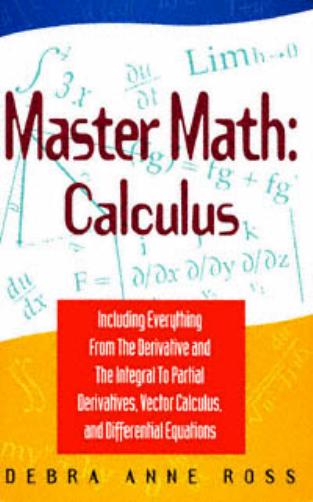Master Math: Calculus by Debra Anne Ross

Author:Debra Anne Ross [Debra Anne Ross]
Language: eng
Format: epub, pdf
Tags: Math & Science
Publisher: Course Technology PTR
Published: 2009-05-31T21:00:00+00:00
3.20 Evaluating Integrals Using Partial Fractions
• This section includes a brief explanation of the method of partial fractions. For a more comprehensive explanation, see a calculus textbook.
• The method of partial fractions is applicable when the integrand is a rational fraction such as a quotient of polynomials. In this method, the fraction is separated into a sum of simple fractions that can be easily integrated. The integral of simple fractions often involves the natural logarithm (except when the denominator is raised to a power). When using partial fractions for certain integrals, it may be helpful to remember that ∫ 1/x dx = ln | x | + c, or for a more complicated function, ∫ 2/(x + 1) dx = 2 ln|x + 1| + c.
• Following is a brief explanation of the method of partial fractions and how to use it to solve an integral:
(a.) First verify that the degree of the numerator is smaller than the degree of the denominator. If the degree of the numerator is equal or larger, divide the leading term of the denominator into the leading term of the numerator.
(b.) Next, factor the denominator.
(c.) Then separate the fractions into simpler fractions and insert unknown constants A, B, C, etc., into each numerator. Each factor will generally become a separate fraction. The new numerators will each contain the part of the original denominator (common denominator) that is absent from its new denominator. The constants make the original integral equal to the simpler fractions.
(d.) Then solve for the unknown constants A, B, C, etc., by setting the sum of the new numerators equal to the original numerator.
(e.) Finally, integrate each new fraction resulting in a sum of logarithms.
• A general relation that can be followed for a fraction with a simple binomial in the denominator and a numerator with its degree less than that of the denominator is:
Download
This site does not store any files on its server. We only index and link to content provided by other sites. Please contact the content providers to delete copyright contents if any and email us, we'll remove relevant links or contents immediately.
| Algebra | Calculus |
| Combinatorics | Discrete Mathematics |
| Finite Mathematics | Fractals |
| Functional Analysis | Group Theory |
| Logic | Number Theory |
| Set Theory |
Modelling of Convective Heat and Mass Transfer in Rotating Flows by Igor V. Shevchuk(6408)
Weapons of Math Destruction by Cathy O'Neil(6221)
Factfulness: Ten Reasons We're Wrong About the World – and Why Things Are Better Than You Think by Hans Rosling(4718)
A Mind For Numbers: How to Excel at Math and Science (Even If You Flunked Algebra) by Barbara Oakley(3262)
Descartes' Error by Antonio Damasio(3250)
Factfulness_Ten Reasons We're Wrong About the World_and Why Things Are Better Than You Think by Hans Rosling(3218)
TCP IP by Todd Lammle(3158)
Fooled by Randomness: The Hidden Role of Chance in Life and in the Markets by Nassim Nicholas Taleb(3083)
Applied Predictive Modeling by Max Kuhn & Kjell Johnson(3043)
The Tyranny of Metrics by Jerry Z. Muller(3034)
The Book of Numbers by Peter Bentley(2935)
The Great Unknown by Marcus du Sautoy(2666)
Once Upon an Algorithm by Martin Erwig(2627)
Easy Algebra Step-by-Step by Sandra Luna McCune(2607)
Lady Luck by Kristen Ashley(2557)
Practical Guide To Principal Component Methods in R (Multivariate Analysis Book 2) by Alboukadel Kassambara(2518)
Police Exams Prep 2018-2019 by Kaplan Test Prep(2518)
All Things Reconsidered by Bill Thompson III(2374)
Linear Time-Invariant Systems, Behaviors and Modules by Ulrich Oberst & Martin Scheicher & Ingrid Scheicher(2348)
